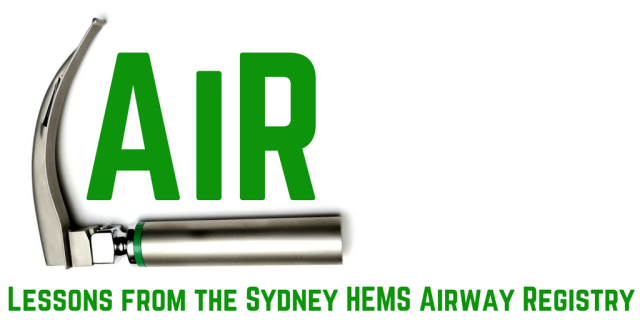
Airway Registry learning points reflect the challenges described and wisdom shared by Sydney HEMS personnel and guests at the Clinical Governance Airway Registry presentations. Cases are discussed non-contemporaneously, anonymised and amalgamated over a period of time to draw together unifying take-home messages. Details of specific cases are removed and/or changed, such that any similarity to real-life patients or scenarios is coincidental.
Sydney HEMs is proud of its commitment to excellence in airway management. In 2022, we achieved:
- 95% overall first pass success rate (first pass of laryngoscope into mouth results in successful intubation, from both prehospital and inter hospital cases, including cold tube and RSI. A change of operator or removal of the blade from the mouth ends the attempt).
- 96.5% first pass success rate from RSI.
These learning points form part of our commitments to excellence, governance and education. All CMAC videos are shared under a Creative Commons Licence: Attribution 4.0 International. Please familiarise yourself with the terms of the licence before reusing our videos.
To view these videos, you will need this password: AiRblogVideos
The AiR blog posts come from the amazing brain of Dr Clare Hayes-Bradley and the Airway Registry Audit team, via the fingertips of Dr Natalie May.
Focus On: Burns
Our burns videos are now collected together in a handy vimeo showcase! Follow this link to see all our burns-related airway videos: https://vimeo.com/showcase/9365611
These two videos come from the same patient, who had life-threatening burns. Due to geography, it was some time after the initial insult before airway management could be attempted. They show two attempts at DL/VL before ultimately the team progressed to front-of-neck access.
This first video shows full thickness burns of the lip, shedding of tongue mucosa and the epiglottis off midline to the right in view initially, then overcome with secretions.
This second video shows the best view achieved on second look – secretions form a veil around a very swollen epiglottis – the laryngeal inlet is not seen. The patient went on to have a surgical airway.
Airway management in advanced burns is notoriously tricky, from a combination of secretions, oedema, soot/carbon and tissue trauma. Often neck movement is also reduced if there is significant burnt neck tissue.
NOTE here – in both videos, bubbles seem to come from everywhere with many secretions, so the adage of “aiming for bubbles” is NOT advisable here – it’s likely there are also bubbles from the oesophagus after difficulty bagging during pre-oxygenation.
Video Focus: Contaminated Airways
The following videos showcase some challenges with contamination.
This older child had a reduced GCS. The video shows significant regurgitation during laryngoscopy; likely swallowed blood and gastric contents.
This patient was intubated as part of resuscitation after drowning. The airway is contaminated with seaweed, appearing as a green foreign body on laryngoscopy.
This is a video from a second look and intubation of a patient in cardiac arrest. The first look yielded “thick vomitus with no discernible landmarks”. It was too thick for the Ducanto catheter but too soft and fragmented for removal with Magill forceps. Improvement of positioning with cessation of compressions gave this view on second look.
Where Can I Find More CMAC Videos?
Try our Vimeo Channel! Don’t forget, you’ll need the same password: AiRblogVideos
Like What You See?
If you like what you do, please consider “buying us a coffee” to help with hosting costs – https://www.buymeacoffee.com/airblogvideos

